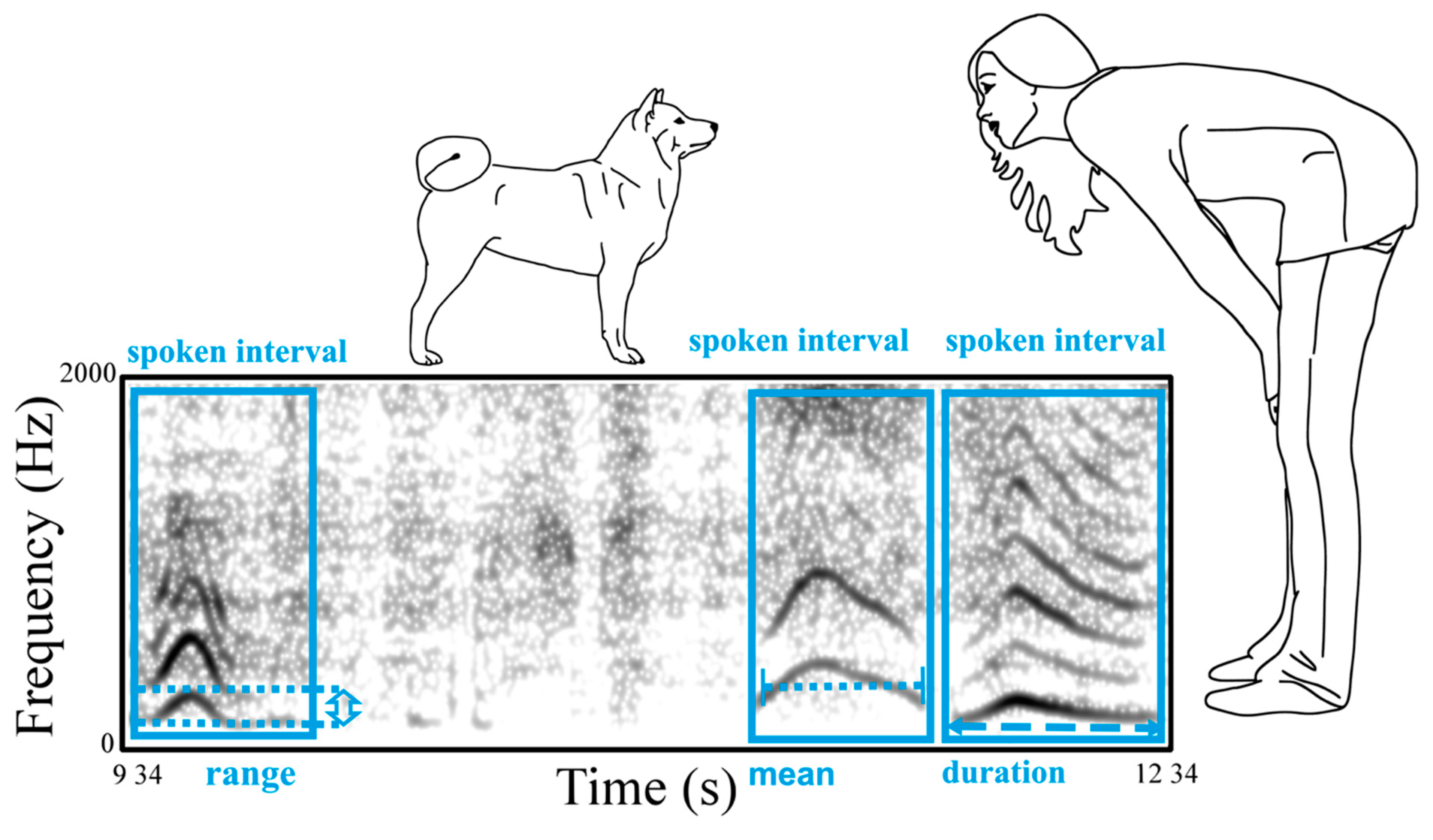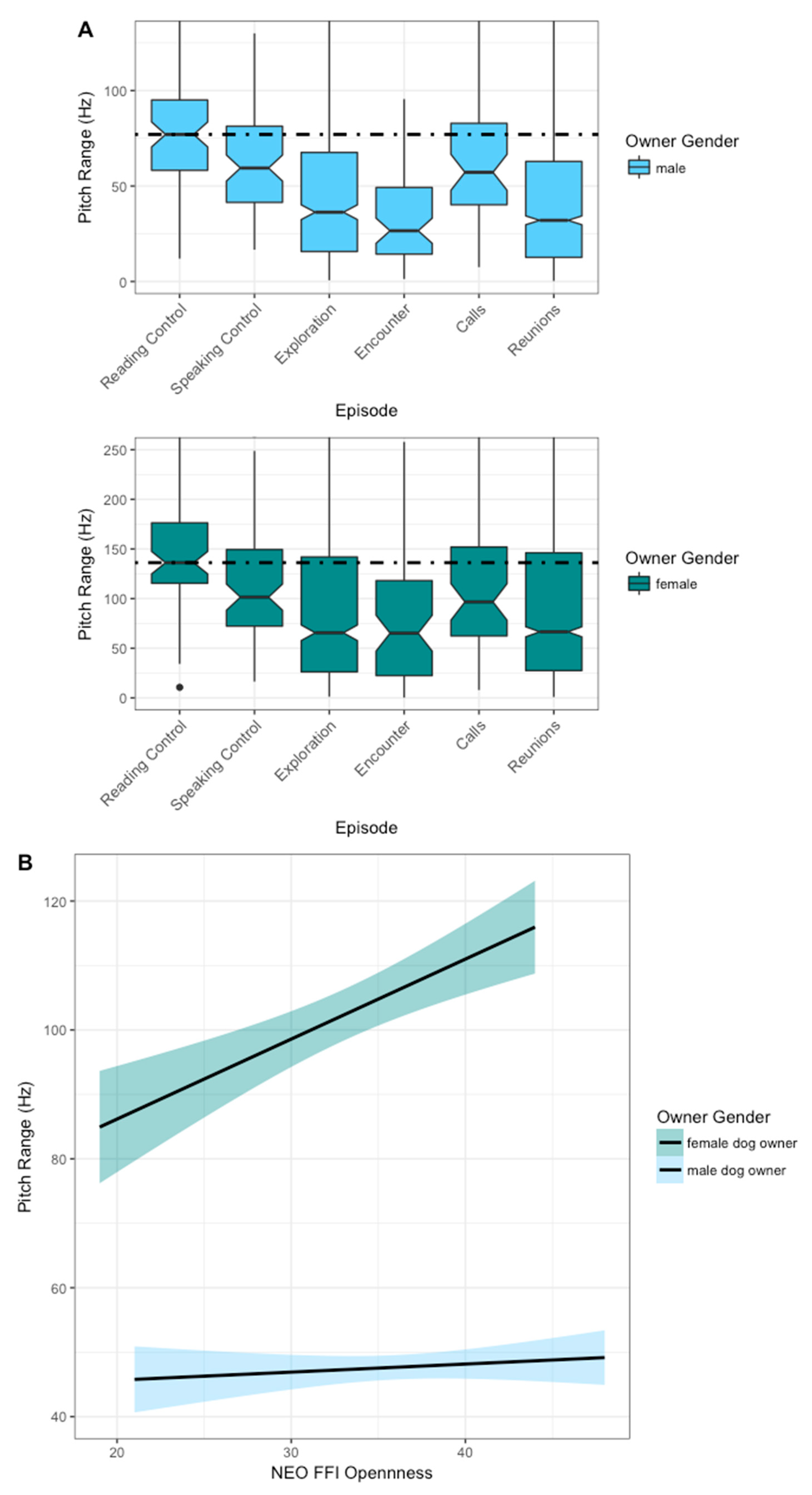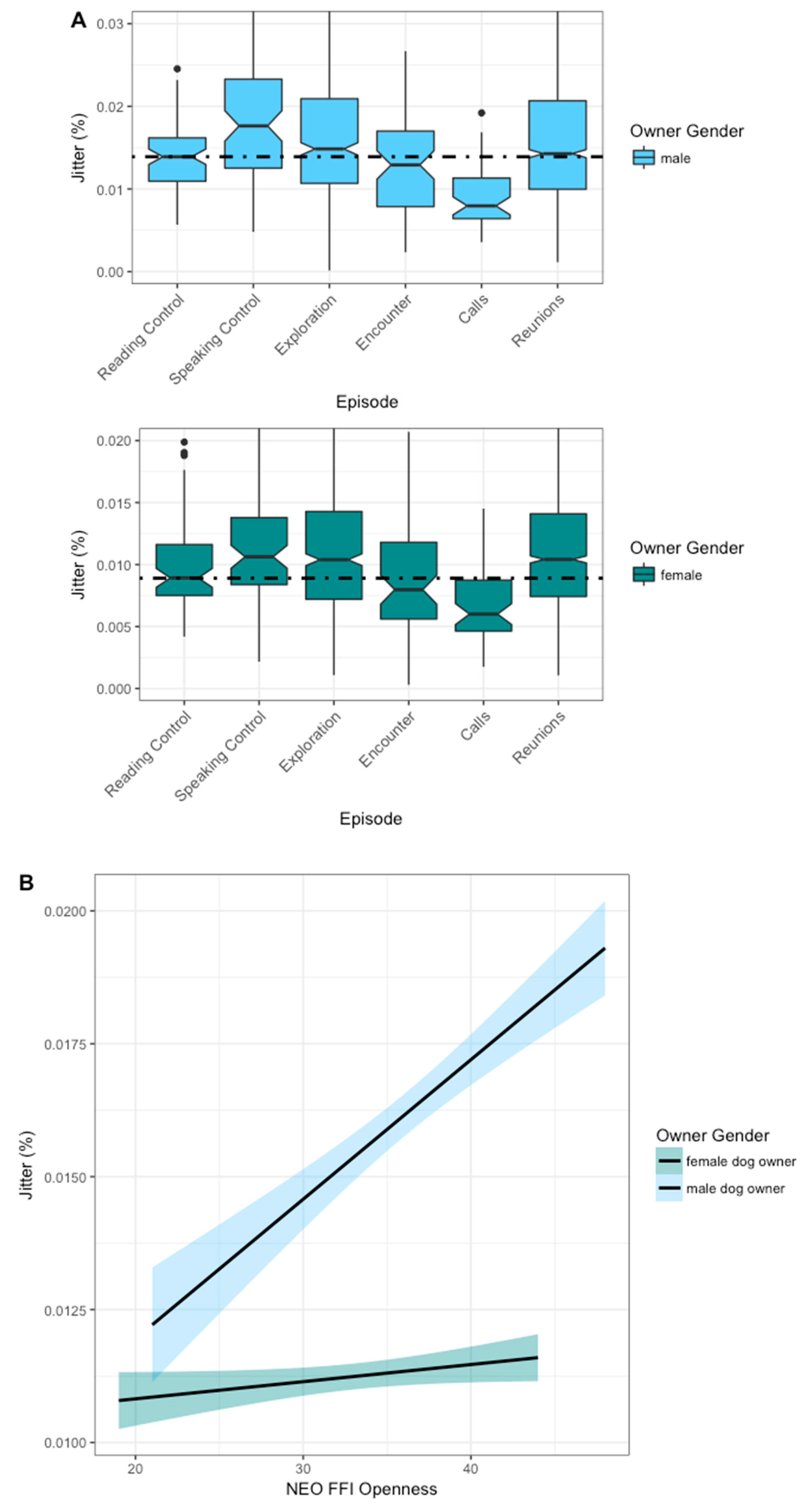Talking to Dogs: Companion Animal-Directed Speech in a Stress Test
Simple Summary
Abstract
1. Introduction
2. Materials and Methods
2.1. Subjects
2.2. Owner Personality Axis
2.3. Ainsworth Strange Situation Procedure
2.4. Video Recording, Surveillance and Animal Welfare
2.5. Dog Attachment Classification
2.6. Owner Caregiving Rating
2.7. Audio Recording
2.8. Audio Treatment and Analysis
2.9. Analyzed Parameters
2.10. Statistical Analysis
2.11. Ethics
3. Results
3.1. Mean Pitch
3.2. Pitch Range
3.3. Jitter
4. Discussion
5. Conclusions
Supplementary Materials
Author Contributions
Funding
Acknowledgments
Conflicts of Interest
References
- Protopapas, A.; Lieberman, P. Fundamental frequency of phonation and perceived emotional stress. J. Acoust. Soc. Am. 1997, 101, 2267–2277. [Google Scholar] [CrossRef] [PubMed]
- Siniscalchi, M.; D’Ingeo, S.; Fornelli, S.; Quaranta, A. Lateralized behavior and cardiac activity of dogs in response to human emotional vocalizations. Sci. Rep. 2018, 8, 77. [Google Scholar] [CrossRef] [PubMed]
- Williams, C.E.; Stevens, K.N. Emotions and Speech: Some Acoustical Correlates. J. Acoust. Soc. Am. 1972, 52, 1238–1250. [Google Scholar] [CrossRef] [PubMed]
- Scherer, K. Vocal affect expression: A review and model for further research. Psychol. Bull. 1986, 99, 143–165. [Google Scholar] [CrossRef] [PubMed]
- Smith, G.A. Voice analysis for the measurement of anxiety. Br. J. Med. Psychol. 1977, 50, 367–373. [Google Scholar] [CrossRef] [PubMed]
- Kagan, J.; Reznick, J.S.; Snidman, N. Biological bases of childhood shyness. Science 1988, 240, 167–171. [Google Scholar] [CrossRef]
- Burnham, D.; Kitamura, C.; Vollmer-Conna, U. What’s new, pussycat? On talking to babies and animals. Science 2002, 296, 1435. [Google Scholar] [CrossRef]
- Burnham, D.; Francis, E. Are you my little pussy-cat? Acoustic, phonetic and affective qualities of infant-and pet-directed speech. In Proceedings of the 5th International Conference on Spoken Language Processing (ICSLP 98), Sydney, Australia, 30 November–4 December 1998. [Google Scholar]
- Ben-Aderet, T.; Gallego-abenza, M.; Reby, D.; Mathevon, N. Dog-directed speech: Why do we use it and do dogs pay attention to it? Proc. R. Soc. B Biol. Sci. 2017, 284, 20162429. [Google Scholar] [CrossRef]
- Xu, N.; Burnham, D.; Kitamura, C.; Vollmer-Conna, U. Vowel hyperarticulation in parrot-, dog- and infant-directed speech. Anthrozoos 2013, 26, 373–380. [Google Scholar] [CrossRef]
- Hoff, E. Language Development; Jon-David Hague: Wadsworth, OH, USA, 2009. [Google Scholar]
- Jeannin, S.; Gilbert, C.; Amy, M.; Leboucher, G. Pet-directed speech draws adult dogs’ attention more efficiently than Adult-directed speech. Sci. Rep. 2017, 7, 4980. [Google Scholar] [CrossRef]
- Julius, H.; Beetz, A.; Kotrschal, K.; Turner, D.C.; Uvnäs-Moberg, K. Attachment to Pets; Hogrefe: Göttingen, Germany, 2012. [Google Scholar]
- Siniscalchi, M.; d’Ingeo, S.; Quaranta, A. Orienting asymmetries and physiological reactivity in dogs’ response to human emotional faces. Learn. Behav. 2018, 46, 574–585. [Google Scholar] [CrossRef] [PubMed]
- Archer, J. Why do people love their pets? Evol. Hum. Behav. 1997, 18, 237–259. [Google Scholar] [CrossRef]
- Kotrschal, K. Hund-Mensch. Das Geheimnis der Seelenverwandtschaft; Brandstätter: Wien, Austria, 2016. [Google Scholar]
- Cassidy, J.; Shaver, P.R. The Nature of the Child’s Ties. In Handbook of Attachment: Theory, Research, and Clinical Applications; The Guilford Press: New York, NY, USA, 1999; Volume XVII. [Google Scholar]
- Bowlby, J. Attachment and Loss. Key Concepts Fam. Stud. 1980, 54, 9–12. [Google Scholar]
- Ainsworth, M. Attachments Beyond Infancy. Am. Psychol. 1989, 44, 709–716. [Google Scholar] [CrossRef] [PubMed]
- Ainsworth, M.D.S.; Blehar, M.C.; Waters, E.; Wall, S. Patterns of Attachment: A Psychological Study of the Strange Situation; Lawrence Erlbaum: Oxford, UK, 1978. [Google Scholar]
- Palestrini, C.; Prato Previde, E.; Custance, D.M.; Spiezio, C.; Sabatini, F.; Verga, M. Heart rate and behavioural responses in dogs (Canis familiaris) in the Ainsworth’s Strange situation stress: A pilot study. In Proceedings of the 3th International Congress on Veterinary Behavioural Medicine, Vancouver, BC, Canada, 7–8 August 2001; Volume 94, pp. 89–91. [Google Scholar]
- Main, M.; Solomon, J. Procedures for idenifying infants as disorganaized/disoriented during the Ainsworth Strange Situation. In Attachment in the Preschool Years: Theory, Research, and Intervention; University of Chicago Press: Chicago, IL, USA, 1990; pp. 161–182. [Google Scholar]
- Ainsworth, M.D.S.; Wittig, B.A. Attachment and the exploratory behavior of one-year olds in a strange situation. Determ. Infant Behav. 1969, 4, 111–136. [Google Scholar]
- Gácsi, M.; Maros, K.; Sernkvist, S.; Miklósi, Á. Does the owner provide a secure base? Behavioral and heart rate response to a threatening stranger and to separation in dogs. J. Vet. Behav. Clin. Appl. Res. 2009, 4, 90–91. [Google Scholar] [CrossRef]
- Palmer, R.; Custance, D. A counterbalanced version of Ainsworth’s Strange Situation Procedure reveals secure-base effects in dog-human relationships. Appl. Anim. Behav. Sci. 2008, 109, 306–319. [Google Scholar] [CrossRef]
- Prato-Previde, E.; Custance, D.M.; Spiezio, C.; Sabatini, F. Is the dog-human relationship an attachment bond? An observational study using Ainsworth’s strange situation. Behaviour 2003, 140, 225–254. [Google Scholar] [CrossRef]
- Topál, J.; Miklósi, Á.; Csányi, V.; Dóka, A. Attachment Behavior in Dogs (Canis familiaris): A New Application of Ainsworth’s (1969) Strange Situation Test. J. Comp. Psychol. 1998, 112, 219–229. [Google Scholar] [CrossRef]
- Gergely, A.; Faragó, T.; Galambos, Á.; Topál, J. Differential effects of speech situations on mothers’ and fathers’ infant-directed and dog-directed speech: An acoustic analysis. Sci. Rep. 2017, 7, 13739. [Google Scholar] [CrossRef]
- Jeannin, S.; Gilbert, C.; Leboucher, G. Effect of interaction type on the characteristics of pet-directed speech in female dog owners. Anim. Cogn. 2017, 20, 499–509. [Google Scholar] [CrossRef] [PubMed]
- Schöberl, I.; Beetz, A.; Solomon, J.; Wedl, M.; Gee, N.; Kotrschal, K. Social factors influencing cortisol modulation in dogs during a strange situation procedure. J. Vet. Behav. Clin. Appl. Res. 2016, 11, 77–85. [Google Scholar] [CrossRef]
- Schöberl, I.; Wedl, M.; Beetz, A.; Kotrschal, K. Psychobiological factors affecting cortisol variability in human-dog dyads. PLoS ONE 2017, 12, e0170707. [Google Scholar] [CrossRef] [PubMed]
- Costa, P.T.; McCrae, R.R. Revised NEO Personality Inventory (NEO-PI-R) and NEO Five-Factor; The Sage Handbook of Personality Theory and Assessment; Psychological Assessment Resources: Odessa, Ukraine, 1992. [Google Scholar]
- Borkenau, P.; Ostendorf, F. NEO-Fünf-Faktoren Inventar:(NEO-FFI); nach Costa und McCrae; Hogrefe: Göttingen, Germany, 1993. [Google Scholar]
- Solomon, J.; Beetz, A.; Schöberl, I.; Gee, N.; Kotrschal, K. Attachment security in companion dogs: Adaptation of Ainsworth’s strange situation and classification procedures to dogs and their human caregivers. Attach. Hum. Dev. 2018, 21, 389–417. [Google Scholar] [CrossRef] [PubMed]
- Matas, L.; Arend, R.A.; Sroufe, L.A. Continuity of Adaptation in the Second Year: The Relationship between Quality of Attachment and Later Competence. Child Dev. 1978, 49, 547–556. [Google Scholar] [CrossRef]
- Grueber, C.E.; Nakagawa, S.; Laws, R.J.; Jamieson, I.G. Multimodel inference in ecology and evolution: Challenges and solutions. J. Evol. Biol. 2011, 24, 699–711. [Google Scholar] [CrossRef] [PubMed]
- Amrhein, V.; Korner-Nievergelt, F.; Roth, T. The earth is flat (p > 0.05): Significance thresholds and the crisis of unreplicable research. PeerJ 2017, 5, e3544. [Google Scholar] [CrossRef] [PubMed]
- Jørgensen, S.E. Model Selection and Multimodel Inference. Ecol. Model. 2004, 172, 96–97. [Google Scholar] [CrossRef]
- Arnold, T.W. Uninformative Parameters and Model Selection Using Akaike’s Information Criterion. J. Wildl. Manag. 2010, 74, 1175–1178. [Google Scholar] [CrossRef]
- Mundry, R. Issues in information theory-based statistical inference—A commentary from a frequentist’s perspective. Behav. Ecol. Sociobiol. 2011, 65, 57–68. [Google Scholar] [CrossRef]
- Trainor, L.J.; Austin, C.M.; Desjardins, N. Is infanct-directed speech prosody a result of the vocal expression of emotion? Psychol. Sci. 2000, 11, 188–195. [Google Scholar] [CrossRef] [PubMed]
- Singh, L.; Morgan, J.L.; Best, C.T. Infants’ Listening Preferences: Baby Talk or Happy Talk? Infancy 2002, 3, 365–394. [Google Scholar] [CrossRef]
- Kitamura, C.; Burnham, D. Pitch and communicative intent in mother’s speech: Adjustments for age and sex in the first year. Infancy 2009, 4, 85–110. [Google Scholar] [CrossRef]
- Siniscalchi, M.; Stipo, C.; Quaranta, A. “Like owner, like dog”: Correlation between the owner’s attachment profile and the owner-dog bond. PLoS ONE 2013, 8, e78455. [Google Scholar] [CrossRef] [PubMed]
- Oswald, L.M.; Zandi, P.; Nestadt, G.; Potash, J.B.; Kalaydjian, A.E.; Wand, G.S. Relationship between cortisol responses to stress and personality. Neuropsychopharmacology 2006, 31, 1583–1591. [Google Scholar] [CrossRef] [PubMed]
- Schöberl, I.; Wedl, M.; Bauer, B.; Day, J.; Möstl, E.; Kotrschal, K. Effects of owner-dog relationship and owner personality on cortisol modulation in human-dog dyads. Anthrozoos 2012, 25, 199–214. [Google Scholar] [CrossRef]





| Parameter | Estimate | Std. Error | Confidence Interval (85%) | Relative Importance | |
|---|---|---|---|---|---|
| 0.075 | 0.925 | ||||
| (Intercept) | 4.7658 | 0.0429 | 4.7041 | 4.8276 | |
| speaking control | −0.005 | 0.0249 | −0.0409 | 0.0309 | 1 |
| exploration | 0.1904 | 0.0196 | 0.1621 | 0.2187 | ´´ |
| stranger | 0.1859 | 0.0263 | 0.148 | 0.2237 | ´´ |
| call (1) | 0.3863 | 0.0353 | 0.3355 | 0.4371 | ´´ |
| reunion (1) | 0.1822 | 0.0194 | 0.1544 | 0.2101 | ´´ |
| call (2) | 0.3756 | 0.0348 | 0.3255 | 0.4257 | ´´ |
| reunion (2) | 0.1453 | 0.0197 | 0.117 | 0.1736 | ´´ |
| gender (female) | 0.5513 | 0.0537 | 0.4739 | 0.6286 | 1 |
| caregiving | −0.0027 | 0.0121 | −0.0596 | 0.0197 | 0.13 |
| extraversion | 0.002 | 0.0101 | −0.0186 | 0.0506 | 0.13 |
| attachment (non-secure) | −0.0035 | 0.0093 | −0.0301 | −0.0259 | 0.13 |
| neuroticism | 0.0015 | 0.0106 | −0.0281 | 0.0545 | 0.12 |
| openness | 0.0009 | 0.0099 | −0.033 | 0.0502 | 0.11 |
| agreeableness | 0.0008 | 0.0089 | −0.0299 | 0.0451 | 0.11 |
| Parameter | Estimate | Std. Error | Confidence Interval (85%) | Relative Importance | |
|---|---|---|---|---|---|
| 0.075 | 0.925 | ||||
| (Intercept) | 4.3426 | 0.0911 | 4.2114 | 4.4738 | |
| speaking control | −0.1656 | 0.1013 | −0.3114 | −0.0199 | 1 |
| exploration | −0.6098 | 0.0799 | −0.7248 | −0.4948 | ´´ |
| stranger | −0.7518 | 0.1072 | −0.9062 | −0.5974 | ´´ |
| call (1) | −0.2962 | 0.1436 | −0.5028 | −0.0895 | ´´ |
| reunion (1) | −0.5974 | 0.0787 | −0.7107 | −0.4841 | ´´ |
| call (2) | −0.3351 | 0.1415 | −0.5388 | −0.1315 | ´´ |
| reunion (2) | −0.618 | 0.079 | −0.7317 | −0.5042 | ´´ |
| gender (female) | 0.788 | 0.0782 | 0.6755 | 0.9006 | 1 |
| openness | 0.0613 | 0.0436 | 0.0179 | 0.127 | 0.85 |
| extraversion | 0.0157 | 0.0303 | −0.0016 | 0.0997 | 0.32 |
| agreeableness | 0.0038 | 0.0159 | −0.0158 | 0.0858 | 0.11 |
| neuroticism | 0.0059 | 0.0217 | −0.0259 | 0.0945 | 0.17 |
| attachment (non-secure) | 0.0053 | 0.0281 | −0.0489 | 0.1668 | 0.09 |
| conscientiousness | 0.0018 | 0.012 | −0.0293 | 0.0751 | 0.08 |
| caregiving | −0.0006 | 0.0099 | −0.0624 | 0.0435 | 0.07 |
| Parameter | Estimate | Std. Error | Confidence Interval (85%) | Relative Importance | |
|---|---|---|---|---|---|
| 0.075 | 0.925 | ||||
| (Intercept) | −4.3029 | 0.0599 | −4.389 | −4.2167 | |
| speaking control | 0.2193 | 0.0532 | 0.1427 | 0.2959 | 1 |
| exploration | 0.1795 | 0.0418 | 0.1193 | 0.2397 | ´´ |
| stranger | 0.0309 | 0.0563 | −0.0501 | 0.1119 | ´´ |
| call (1) | −0.4104 | 0.0754 | −0.5189 | −0.3019 | ´´ |
| reunion (1) | 0.146 | 0.0413 | 0.0865 | 0.2055 | ´´ |
| call (2) | −0.2983 | 0.0746 | −0.4057 | −0.191 | ´´ |
| reunion (2) | 0.1679 | 0.0415 | 0.1082 | 0.2276 | ´´ |
| gender (female) | −0.3087 | 0.0652 | −0.4025 | −0.2148 | 1 |
| openness | 0.0531 | 0.0358 | 0.0156 | 0.1063 | 0.87 |
| caregiving | 0.0037 | 0.0145 | −0.0181 | 0.0686 | 0.15 |
| extraversion | −0.0023 | 0.0115 | −0.0575 | 0.0212 | 0.13 |
| agreeableness | 0.001 | 0.01 | −0.0331 | 0.0509 | 0.11 |
| attachment (non-secure) | −0.0013 | 0.0207 | −0.1025 | 0.0784 | 0.1 |
| neuroticism | −0.0004 | 0.0103 | −0.0496 | 0.0422 | 0.1 |
© 2019 by the authors. Licensee MDPI, Basel, Switzerland. This article is an open access article distributed under the terms and conditions of the Creative Commons Attribution (CC BY) license (http://creativecommons.org/licenses/by/4.0/).
Share and Cite
Lesch, R.; Kotrschal, K.; Schöberl, I.; Beetz, A.; Solomon, J.; Fitch, W.T. Talking to Dogs: Companion Animal-Directed Speech in a Stress Test. Animals 2019, 9, 417. https://doi.org/10.3390/ani9070417
Lesch R, Kotrschal K, Schöberl I, Beetz A, Solomon J, Fitch WT. Talking to Dogs: Companion Animal-Directed Speech in a Stress Test. Animals. 2019; 9(7):417. https://doi.org/10.3390/ani9070417
Chicago/Turabian StyleLesch, Raffaela, Kurt Kotrschal, Iris Schöberl, Andrea Beetz, Judith Solomon, and W. Tecumseh Fitch. 2019. "Talking to Dogs: Companion Animal-Directed Speech in a Stress Test" Animals 9, no. 7: 417. https://doi.org/10.3390/ani9070417
APA StyleLesch, R., Kotrschal, K., Schöberl, I., Beetz, A., Solomon, J., & Fitch, W. T. (2019). Talking to Dogs: Companion Animal-Directed Speech in a Stress Test. Animals, 9(7), 417. https://doi.org/10.3390/ani9070417





